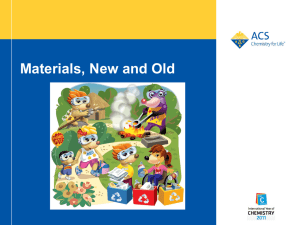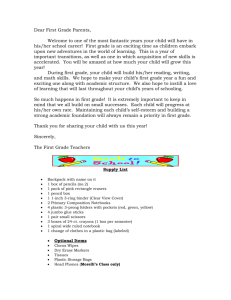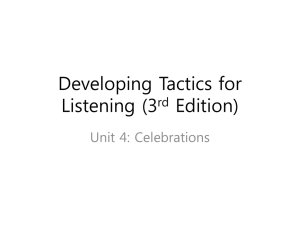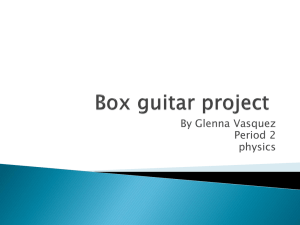0ef7703249e7ec56d3835151b7ca0dee
advertisement
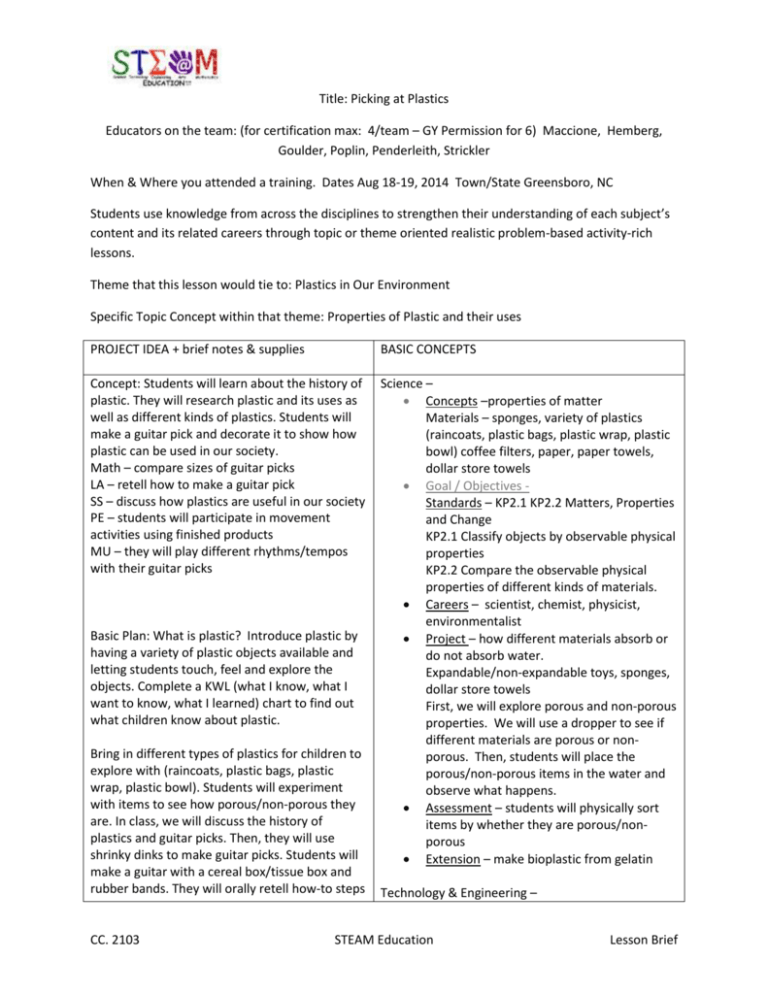
Title: Picking at Plastics Educators on the team: (for certification max: 4/team – GY Permission for 6) Maccione, Hemberg, Goulder, Poplin, Penderleith, Strickler When & Where you attended a training. Dates Aug 18-19, 2014 Town/State Greensboro, NC Students use knowledge from across the disciplines to strengthen their understanding of each subject’s content and its related careers through topic or theme oriented realistic problem-based activity-rich lessons. Theme that this lesson would tie to: Plastics in Our Environment Specific Topic Concept within that theme: Properties of Plastic and their uses PROJECT IDEA + brief notes & supplies BASIC CONCEPTS Concept: Students will learn about the history of plastic. They will research plastic and its uses as well as different kinds of plastics. Students will make a guitar pick and decorate it to show how plastic can be used in our society. Math – compare sizes of guitar picks LA – retell how to make a guitar pick SS – discuss how plastics are useful in our society PE – students will participate in movement activities using finished products MU – they will play different rhythms/tempos with their guitar picks Science – Concepts –properties of matter Materials – sponges, variety of plastics (raincoats, plastic bags, plastic wrap, plastic bowl) coffee filters, paper, paper towels, dollar store towels Goal / Objectives Standards – KP2.1 KP2.2 Matters, Properties and Change KP2.1 Classify objects by observable physical properties KP2.2 Compare the observable physical properties of different kinds of materials. Careers – scientist, chemist, physicist, environmentalist Project – how different materials absorb or do not absorb water. Expandable/non-expandable toys, sponges, dollar store towels First, we will explore porous and non-porous properties. We will use a dropper to see if different materials are porous or nonporous. Then, students will place the porous/non-porous items in the water and observe what happens. Assessment – students will physically sort items by whether they are porous/nonporous Extension – make bioplastic from gelatin Basic Plan: What is plastic? Introduce plastic by having a variety of plastic objects available and letting students touch, feel and explore the objects. Complete a KWL (what I know, what I want to know, what I learned) chart to find out what children know about plastic. Bring in different types of plastics for children to explore with (raincoats, plastic bags, plastic wrap, plastic bowl). Students will experiment with items to see how porous/non-porous they are. In class, we will discuss the history of plastics and guitar picks. Then, they will use shrinky dinks to make guitar picks. Students will make a guitar with a cereal box/tissue box and rubber bands. They will orally retell how-to steps CC. 2103 Technology & Engineering – STEAM Education Lesson Brief for making a guitar pick. In PE, they will complete rhythm based patterns with their bodies. The children will be assessed on how plastics can be used/reused to help us. Skill level (Grade Range): Kindergarten Timing of Lesson: 1 month – 20-25 minutes a day Basic Supplies: Tissue boxes or cereal boxes Paper towel rolls Paint/paintbrushes Shrinking plastic sheets Markers Rubber bands ( will be stretched around the guitar body) Poster board Toaster oven Scissors All Subjects: Individual Subjects: IT Resources: www.youtube.com/watch?v=8CfL5xl2N1Q How Its Made- Plastic Bags (will show a short portion of the video) CC. 2103 Concepts – designing and constructing a guitar pick Goal / Objectives Standards – KP2.1 KP2.2 Matters, Properties and Change KP2.1 Classify objects by observable physical properties KP2.2 Compare the observable physical properties of different kinds of materials. Careers – instrument engineer, instrument designer, instrument craftsman Project - shrinking the plastic and making a finished product, make a guitar out of a tissue or cereal box. Teacher-led research on different kinds/types of guitar picks using internet and technology in the classroom. Guitar design will be based on the shape of the boxes that were donated (tissue box, cereal box).They will build by attaching the “neck” (paper towel tube) using tape/glue with the help of a teacher. They will attach the rubber bands for the strings. They will compare/contrast their guitars to a real guitar. Assessment – participation in the finished product and also assessment of whether they made a usable guitar and guitar pick. Math – Concepts – measurement, estimation Goal / Objectives Standards – K.MD.1 Describe measureable attributes of objects, such as length or weight K.MD.2 Directly compare 2 objects with a measureable attribute in common Careers – data analyst Project – how many of the little picks will fit into a big one? Compare size before and after the shrinkage. They will use some preshrunk shrinky dink picks and compare them to the finished guitar picks. Students can sort piles of the guitar picks into groups based on size/thickness. Assessment – Can students make a good estimation of how many will fit into a large STEAM Education Lesson Brief www.youtube.com/watch?v=wnRRDIFNxoM&list =PL72931AA82BC79F29&index=8 LEGO… The Building Blocks of Fun Other Resources: Contact recycling center to find out about different types of recyclable plastics and what recycled plastic is turned into. Misc: Gifted – write their own instructional step by step for making the guitar pick Photos: pictures will be added as project is completed (copyright laws prevent us from copying and pasting photographs from the internet). Not if you cite them. LA – SS – Art – CC. 2103 pick? And can they check their guess. Extension - time it takes to shrink the pick, size of decorations before and after Concepts – speaking, listening Goal / Objectives Standards – SL.K.1 Participate in collaborative conversations with diverse partners RI.K.1 With prompting and supporting, ask and answer questions about key details. Careers – author for instructional manuals, cookbooks Project – Step by step, how-to instruction (will be completed whole group) We will make a simple chart with pictures and words for the students to refer to. Assessment – Orally retell the steps for making a guitar pick. Concepts – history of plastic and guitar picks and how it has changed over time Goal / Objectives Standards – K.H.1.1 Explain how things have changed over time Careers – historian, researcher, Project - show a video on a factory making plastics, beginning, middle and end of manufacturing process We will complete a Then/Now discussion as a class using real plastic and non-plastic objects (ex. plastic bags/paper bags, glass bottle/plastic bottle, paper milk carton/plastic milk carton). We will focus on the benefits of using plastic versus other items. Assessment – Draw a picture of a plastic item and dictate how that item is useful. Concepts – decorating the guitar pick and making a guitar out of a tissue box/cereal box. Goal / Objectives Standards – STEAM Education Lesson Brief PE – K.V.2.3 Create original art that does not rely on copying or tracing K.V.3.1 Use a variety of tools safely and appropriately to create art Careers – artist, guitar maker Project – decorate their guitar pick using permanent markers (because the markers can withstand the high temperatures needed to make the guitar picks, while paint and washable markers will not withstand the high temperatures). Students will decorate the pick using their first initial and at least 2 colors. They will make a guitar out of a tissue or cereal box. Tools used will be scissors, markers, wax paper, spatula, toaster oven, oven mitts and cookie sheet. Assessment – Does the children’s guitar pick and guitar work and is it visually pleasing? A rubric will be used to assess final products (2 colors, first initial, when pick is used does it produce a sound) Concepts – creating rhythms and beats with body motions Goal / Objectives Standards – PE.K.MS.1.4 Use non-locomotor and locomotor skills in response to even and uneven rhythms in order to integrate beat awareness Careers – dance instructor, dancer Project – students will participate in rhythm based patterns using hands, feet, body. Students will use the instrument they built in T & E. Assessment – can they do simple AB, ABC, ABB patterns with their bodies? Music – Concepts – to play a simple rhythm using the guitar and guitar pick Goal / Objectives Standards – K.ML.1.3 Execute simple rhythms using body, instruments, or voice Careers – musician, music teacher, composer Project – play the guitar with the picks CC. 2103 STEAM Education Lesson Brief CC. 2103 Assessment – can they play a short song on the guitar? STEAM Education Lesson Brief

